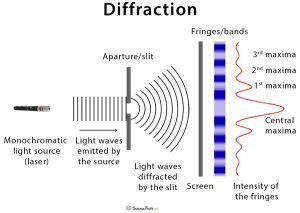
When it comes to refraction, there are no types. Fraunhofer diffraction occurs when both the source and the screen are at infinite distance from the obstacle, thus, producing plane wave fronts. As a result, the wave front is spherical after encountering the obstacle, hence producing a fringed image. Fresnel diffraction occurs when the light source and the screen are at a finite distance from the obstacle causing the diffraction. The two types of diffraction are Fresnel diffraction and Fraunhofer diffraction. What are the types of refraction vs diffraction? This section addresses some of these questions. Refraction vs Diffraction Commonly Asked Questions about Refraction vs Diffractionīecause refraction and diffraction are common occurrences in nature, there are numerous questions about them. Refraction can make objects appear in a different position than they are.ĭiffraction does not result in optical illusions as with refraction. In diffraction, the wave disperses in addition to the bending. In refraction, there is only bending of the wave. The major contributor to the refraction of a wave is its change in speed.ĭiffraction increases with increasing wavelength. Or it can occur within the same medium when there is a density change.ĭiffraction is a result of encountering obstacles or apertures on the wave path. It occurs only at the interface when moving from one medium to another.

However, there are basic differences between refraction vs. Refraction and diffraction are similar wave properties because they both entail the bending of traveling waves. Refraction is noticeable when waves move between media of different densities, unlike diffraction that can occur within the same medium.Ĭourtesy: Student-baba Difference Between Refraction and Diffraction In Physics, it is common to refer to this expression as Snell’s law or the law of refraction. The speed of the light wave in the first and second media ( v 1 and v 2), as well as the refractive index of both media ( n 1 and n 2), are related to the angles of incidence ( θ 1) and refraction ( θ 2) as follows: But when they enter a denser medium such as glass, speed reduces, and direction changes at the interface of the two media. When it comes to light waves, they are fastest in a vacuum and air.

Although refraction of light waves is the most noticeable, other wave forms such as sound and water also experience it. Moreover, this change in direction is because of a change in the speed of the wave or the difference in the densities of the media. Refraction is the redirection of a wave when it passes from one medium to another. In this article, you will learn about the concepts of refraction and diffraction, their differences, and review commonly asked questions about each phenomenon. Moreover, they are important concepts in the field of physics with a variety of applications. Refraction refers to the change in direction of a wave, while diffraction is the spreading of waves.


 0 kommentar(er)
0 kommentar(er)
